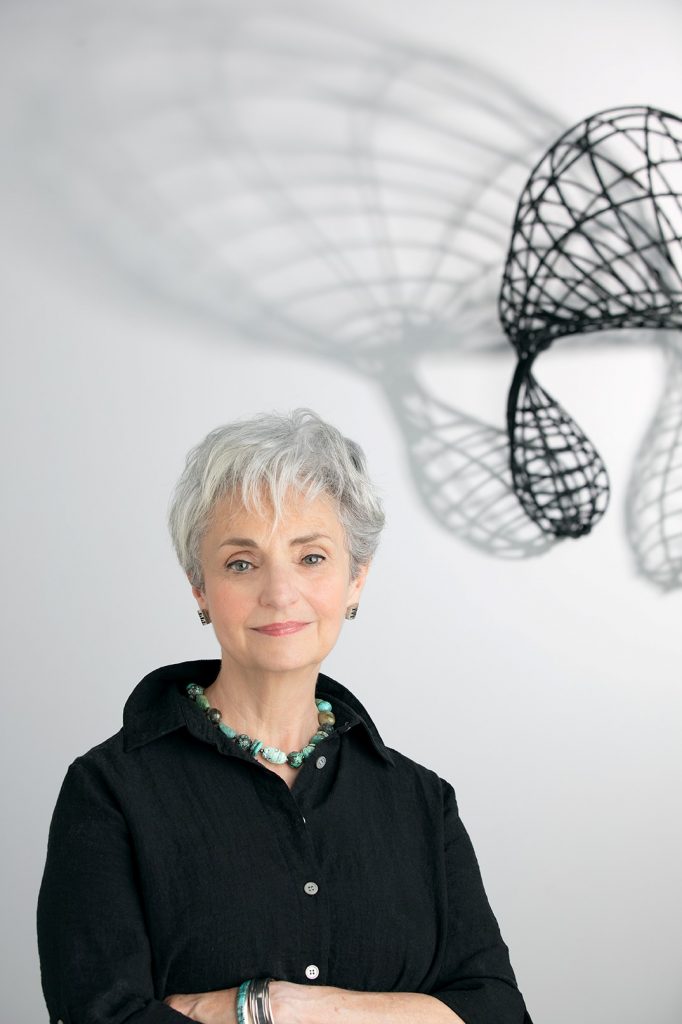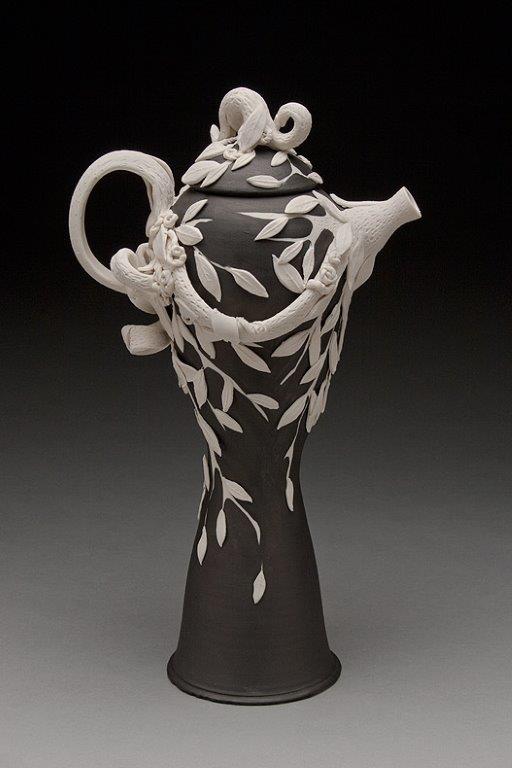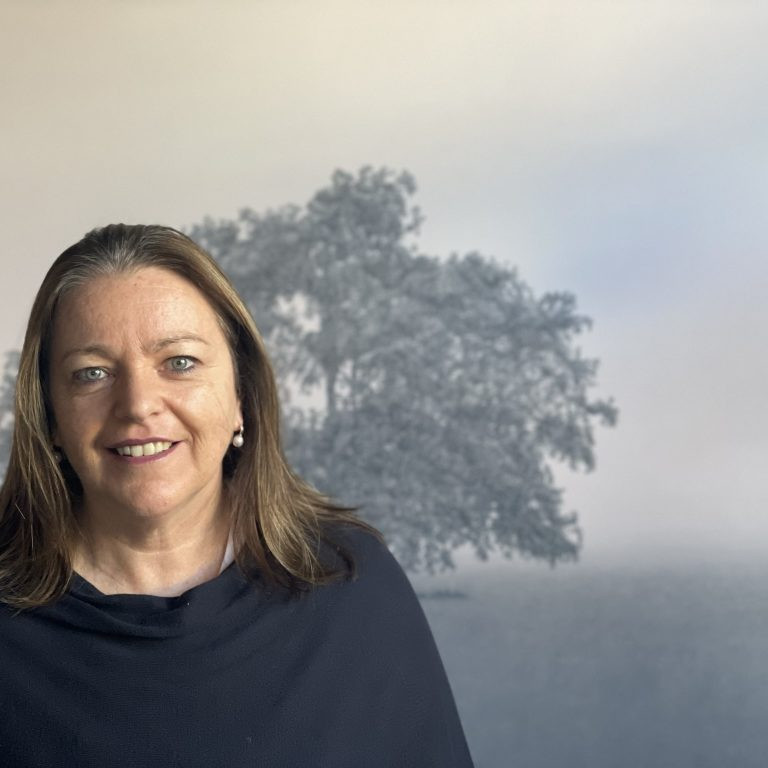Eileen Braun Sculpture
How did Spruill Arts help you to establish the direction you wanted your art to move to?
After 2 years of concentrated encaustic wax development, I felt I was ready to introduce my new cohesive body of work. I approached Spruill Gallery Director Jennifer Price. Her enthusiasm for the work I presented gave me the confidence to push myself and fill the gallery (1,300 sq Ft). Mounting a solo show allowed me to visualize the unifying theme of my work.
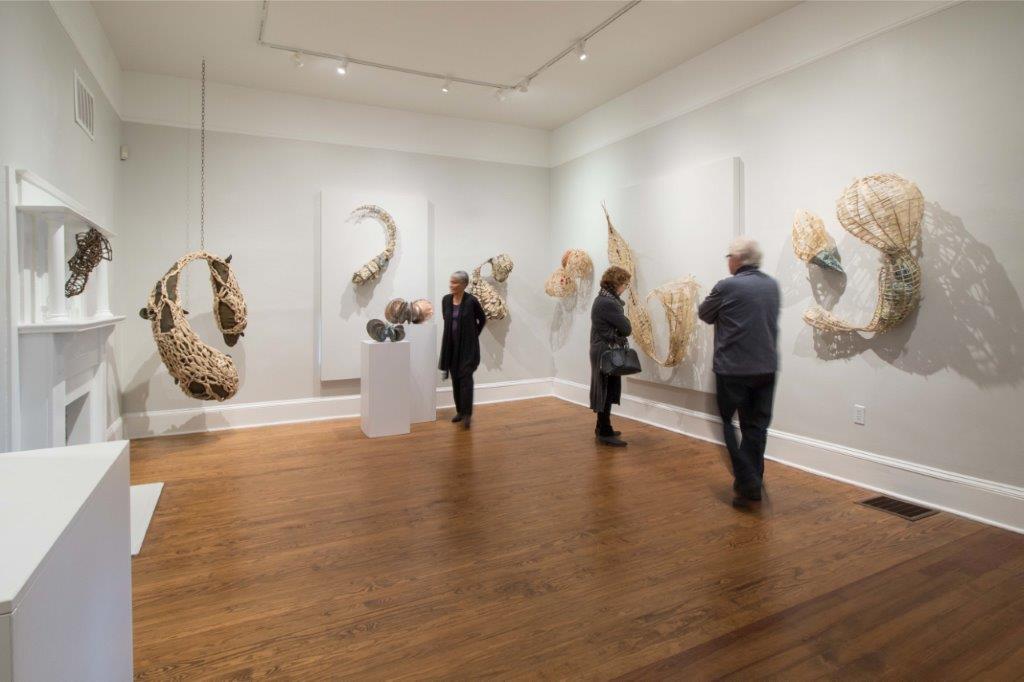
Spruill Gallery Interior: Peopled. Questionable Origins Exhibition 2020, Atlanta GA
How have you been able to use your time as executive director of the Croton-Cortlandt Center for the Arts (C.C.C.A., Westchester NY 1990-96) and manager of the gift shop at Spertus Museum of Jewish Heritage (Chicago, IL 1996-2004) to understand how to put your art work forward?
Working as a liaison between artists, gallery and collector prepared me to present myself for a career in the visual arts.
In 1990 our family relocated to the New York City suburbs and I took on the job of Executive Director of a very small arts center. Three classes! By the time we relocated once again (1996) The center had grown to 80 classes and 3 exhibition pop-up spaces – one in a large shopping mall. The innovative pop-up shopping mall gallery was staffed by the contributing artists. Placing the gallery in a shopping mall made it accessible and comfortable to viewers of all ages who had never been inside a formal gallery setting. The gallery’s story was covered in the NYT! We relocated the gallery within the mall to un-leased space every 3 months and called it “Art Moves”. I learned a great deal about mounting an exhibition and the huge amount of work that goes into the task of a successful gallery. I so appreciate the complexity and hard work of galleries that now promote my work.
Through my experience creating and managing the CCCA’s 3 galleries I acquired the knowledge of what I believe galleries look for from an artist.
- A defined consistent body of work.
- Technical proficiency.
- Resume built of exhibitions and completions- awards are a nice extra.
- Quality photography.
Can you give us a brief history of your arts progression?
I stumbled into working with clay (1988-90) at a local college. It was the only class that fit into my schedule and the medium I had not tried while completing my BA in Art and Art Education at Indiana University.
I fell in love with everything about clay. Of course, I also relished time spent with adults who felt the same passion for art making. On a lark, I took some of my fired vessels to a fine craft gallery. They bought every sample I brought and ordered T-shirts similar to the one I was wearing.
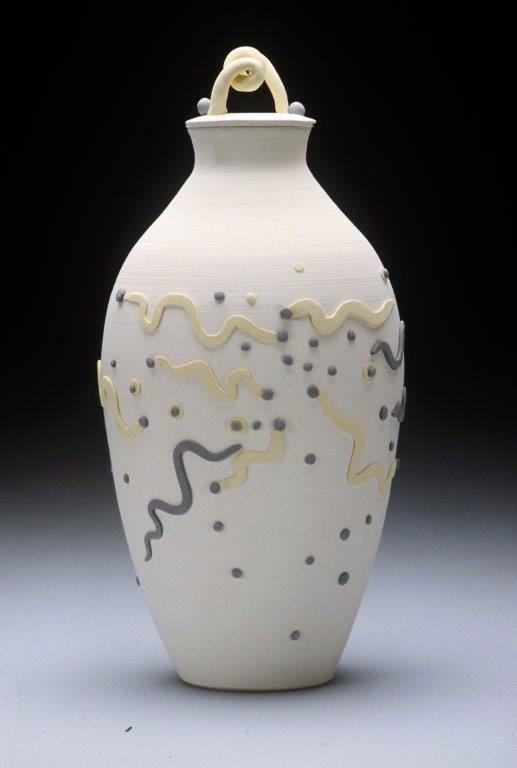
Early work Image. Untitled Vessel Ceramic 13”H X 5.5” W. Wheel Thrown with hand colored clay embellishments.
You worked in ceramics but in the last few years you have moved from clay. Why?
I returned to clay in 2004, after several more arts related jobs and relocations setting up a studio in my Atlanta Georgia home. I auditioned several clay bodies before choosing porcelain – actually, it was more like porcelain chose me. I fell hard for the qualities exclusive to porcelain : creamy smoothness, bright white body and luster when fired. My training in clay is mostly self-directed. Research and a huge amount of experimentation= failures. I pushed and pleaded with the porcelain to break rules. I incorporated wheel throwing, hand-building, sprig molds, adapted new techniques and made my own tools. Because of the temperamental qualities of porcelain clay, I had to babysit the work constantly. Porcelain is known for its wayward cracking, slumping, shrinking and collapsing. Visiting my family long distances away became problematic. I became fearful of dire construction faults that might transpire in my absence from the studio. I came to the conclusion something had to change.
After 12 years of working in clay I went cold turkey from making any art for one year. I did not go into my studio but to grab a new sketchbook and pencils. I drew a lot. Visited museums, galleries and visited artist studios seeking a new medium.
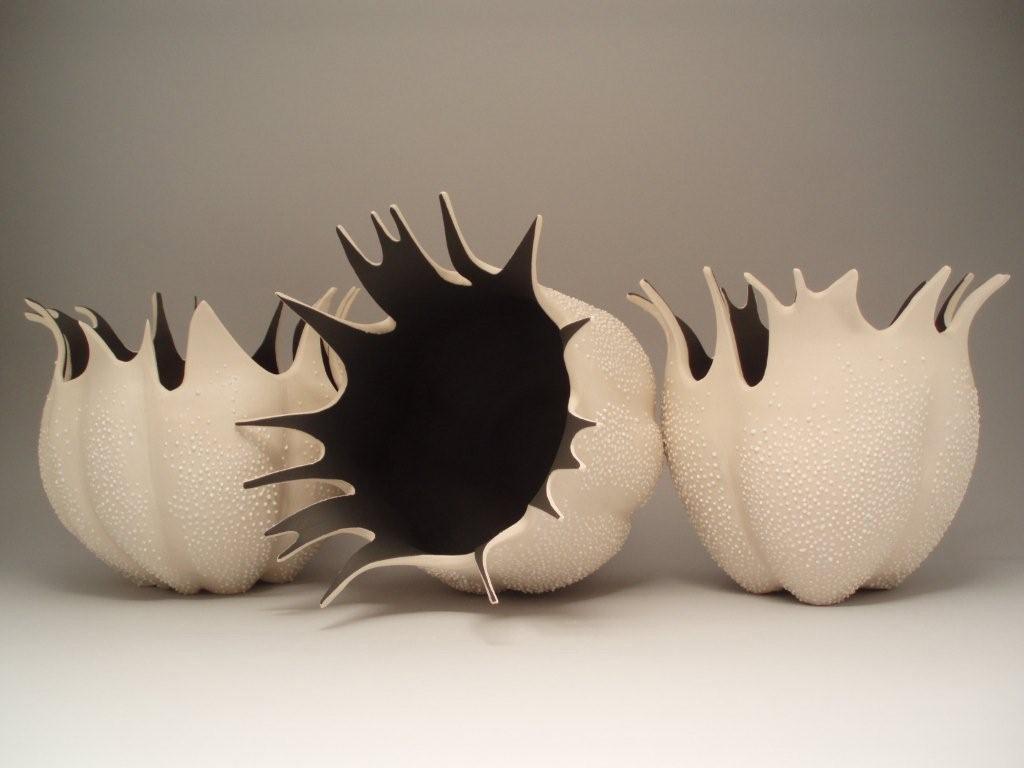
Splash Bowl Series 2014-2016. Porcelain. Vary in size 6-11”H x 6-11” W. Wheel thrown and altered with low fired glaze
Can you give us the top five things you knew you wanted your art to be for you personally?
FIVE OBJECTIVES FOR MY NEW MEDIUM
- Size & weight: I did not want my materials to limit my sculpture. Now I just need to be careful they fit through my studio door and into my car.
- Physical material strength: I sought out materials that would be more reliable and forgiving than clay throughout the construction process.
- Freedom: I wanted the ability to walk away from my studio for more than 5 minutes.
- Health: No more 25# bricks of clay to tote up and down stairs. My current concerns are to simply keep the overhead fans on and window open while working with the potentially toxic molten wax fumes.
- Supplies & Tools: I was not looking for a huge financial investment. Well, I almost got away with this one. Encaustic wax can be expensive.
Jasper Ware Teapot 2016. Porcelain. Wheel thrown, stacked, altered with sprig embellishments and low fired glaze
Can you share with us some of your early attempts with Encaustic wax?
In 2016 I transitioned to a paper mâché like material utilizing recycled materials. It felt a bit like clay with benefits. When my first successful forms were completed, I sought to address their surface. All attempts I felt were failures until I came across an exquisite encaustic wax painting at the Broad Museum (LA, CA). I was blown away by possibilities: Smoky, opaque, translucent, transparent, rough, smooth, shiny, matte, transformative and its ability to conceal or reveal!! And OH!! That awesome honey fragrance. I took a one-week class with encaustic wax sculpture Miles Conrad in Tucson AZ and I was in a state of artful bliss.
As I mentioned previously, I enjoy researching. I pride myself in making work that becomes unique in my hands. Experimentation is supreme and BIG FUN. Have I mentioned that my husband’s career is in the sciences? My days are filled with hands on creative “what ifs”. Evenings are conversations of safe possibilities combining materials. My studio shelves are like many artists, a pallet of cast offs to be repurposed. All kinds of string, threads, natural materials from dried organic vegetation to cast off clothing whose nubby fibers intrigue me and industrial construction materials. I so enjoy a jaunt through a hardware store!
My use of rattan reed was a happy cross pollination. I came across a box of reed stashed away for use as teapot handles. It had all the inherent good qualities for wax absorption and the bonus to transform shape. I used it first on my sculpture “Nesting Instinct”. Then I just went to town seeing what might happen next.
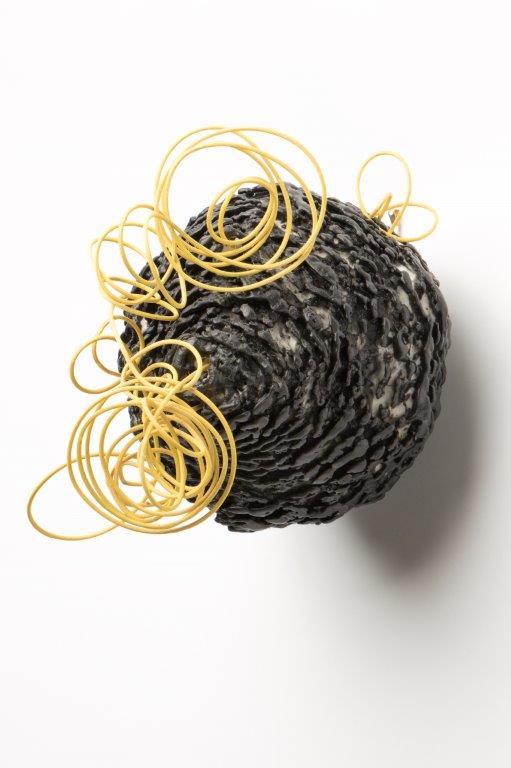
Nesting Instinct 2017. 14”H X 14” W X 14” D. Encaustic wax, Recycled paper, Adhesive, Rattan reed and paint.
My next “Aha” moment was viewing an exhibition at R.A.M. In Toronto Canada. I viewed an exhibition hall filled with ship models. Many had their hull bracing exposed to reveal the construction technique. There were more than historic salesman models on view. This collection displayed vessels of all sizes constructed by French POWs of the 1803-1815 Napoleonic Wars. The prisoners used whatever they could lay their hands on to build with. Bleached bones from their meager meals, threads from their clothing, pebbles and wood from their cell walls- talk about being creative with materials! These were my people!
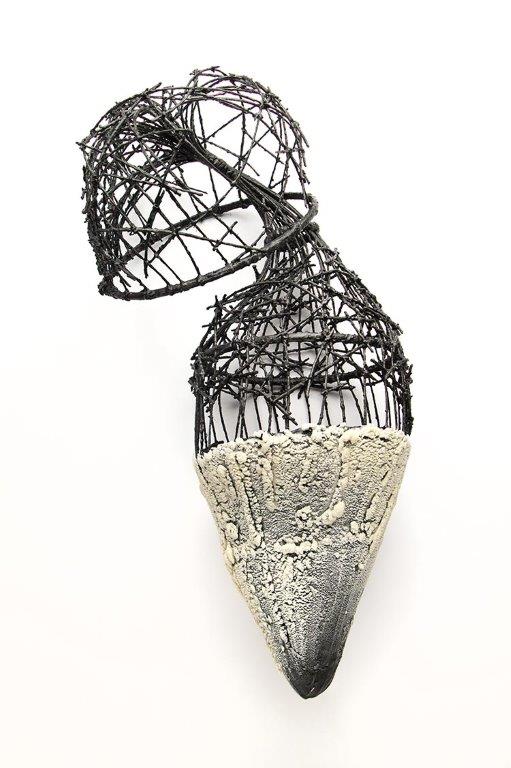
Turning Point 2017. 44”H X 16” W X 14” D. Encaustic wax, Rattan reed, Fabric, Cotton string, Adhesive and Wood stain.
Discuss the OHS needed for using wax in Encaustic work.
Miles taught me the safety guidelines for working with encaustic wax. Ventilation being foremost, no flammable work surfaces, proper safety attire: eyewear, gloves, long sleeves. I learned what materials can be safely combined with the wax for absorbency and stability.
Ecaustic wax has been used since the 5th century B.C. By Greek artisans. That being said there are rules to abide by such as routinely heat setting and allowing the work to cure. Yes, the wax will melt if exposed to extreme heat (200F or 93C) but one has bigger things to worry about if your art is exposed to an environment whose temperatures exceed that.
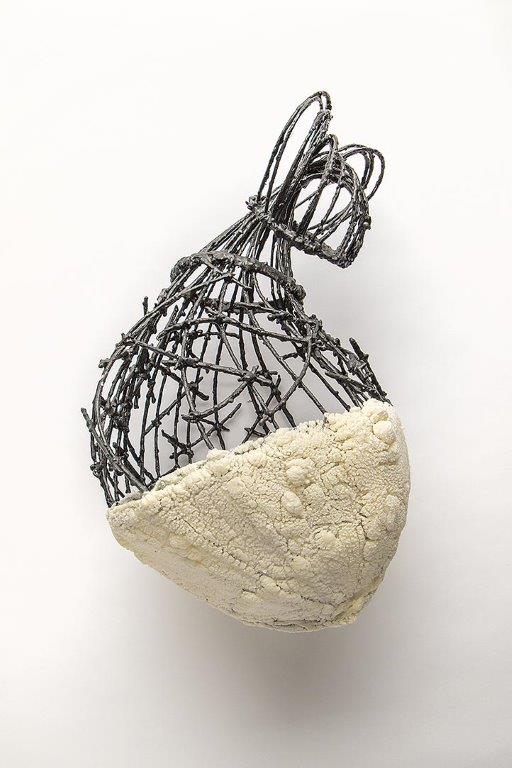 Set Free 2017. 26”H X 15” W X 13” D. Encaustic wax, Rattan reed, Fabric, Cotton string, Adhesive and Wood stain.
Set Free 2017. 26”H X 15” W X 13” D. Encaustic wax, Rattan reed, Fabric, Cotton string, Adhesive and Wood stain.
Shadows are especially important in your final exhibiting of your work – discuss.
Shadows are cast by the animated gestural forms tethered to the wall. These shadows soften the hard lines and enlarge and deepen the work while expanding the power of the object. I have created the object, but the object has liberated itself and gone beyond. My hope is that the when approaching the viewer will be drawn in by the relaxed floating form; then intrigued by the ever-changing views of the work – seeing both through and around simultaneously.
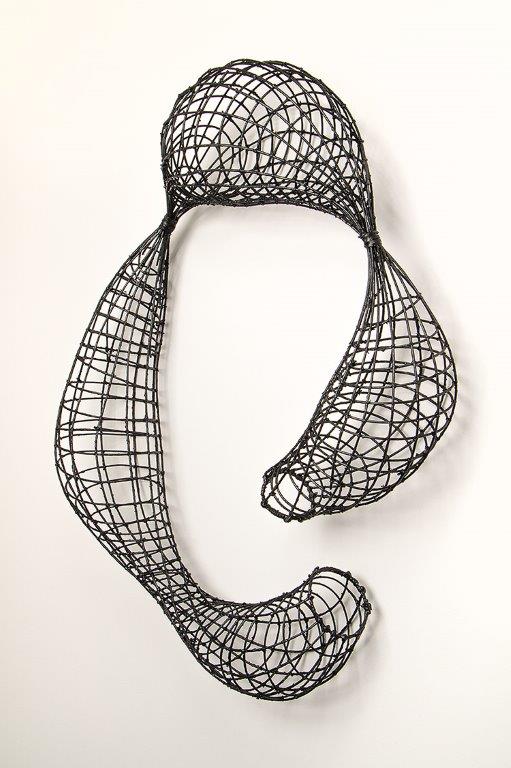
Smoke 2017. 62”H X 48” W X 19” D. Encaustic wax, Rattan reed, Cotton string, Adhesive and Wood stain.
What concerns do you have about the fragility of your work?
None at present. Hurrah. Other than someone inadvertently sitting on my work. My sculptures are very strong because of my unique construction process – they are not woven- more like spun.
Comment on how you trick the viewer into see your work as metallic.
Um. It is a trick of sorts. Thank you, Rumpelstiltskin. My work that is enrobed in black encaustic wax also has a fine mica dust mixed into the molten wax. My iron and copper patinas are created with a layered combination of specialty paints and encaustic wax.
Pretty amusing to see me lifting a HUGE sculpture one handed from out of my car transporting it into a gallery. I get lots of stares and often someone rushing in to assist me. Love it.
Oh, and may I also add that my father’s occupation was testing metallurgical samples-by x-ray. In many ways my sculptures can be seen as exposed metal skeletal hulls.
What other materials are you use currently?
Experimentation never stops with me. Yes, I use that word a lot too. Recently I added dressmaker’s pattern tissue to my forms. Another material that sat on my studio shelf awaiting transformation. I appreciate the tawny color, texture of the paper with its printed instruction guides of dots, lines, and arrows. I started with adhering the paper flat, similar to its use on an Akari Lamp Shade. I have since pushed onward to a form of Guerilla Knit Bombing, Folding and now Brooming – my own term of bunching and tying- my current focus. The paper has so many potential applications. Some serious while others playful. Very exciting.
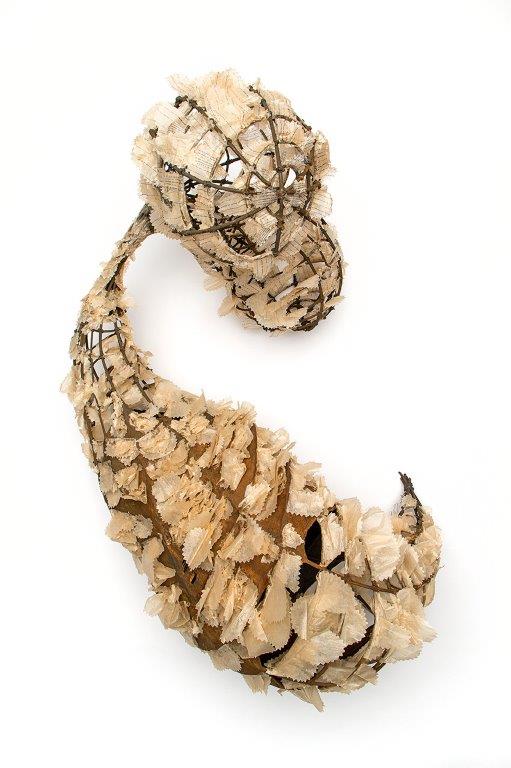
Swoosh 2018. 35”H X 37” W X 23” D. Encaustic wax, Rattan reed, Fabric, Cotton string, Adhesive, Dress maker’s tissue and Specialty paints.
Discuss the preplanning of your work that you know is necessary before beginning.
Sketching a piece is a very important meditative phase. I see my work as architectural and gestural. Through drawing I first define the shape I am attempting to achieve. Then I devise the most efficient way to construct the form. Some of my work is like building a ship in a bottle. I seem to be building the inside and the outside simultaneously. The next phase is to visualize the finished size. It is here when I select and prepare the appropriate gauge reed for strength and then soak my materials 24-48 hours.
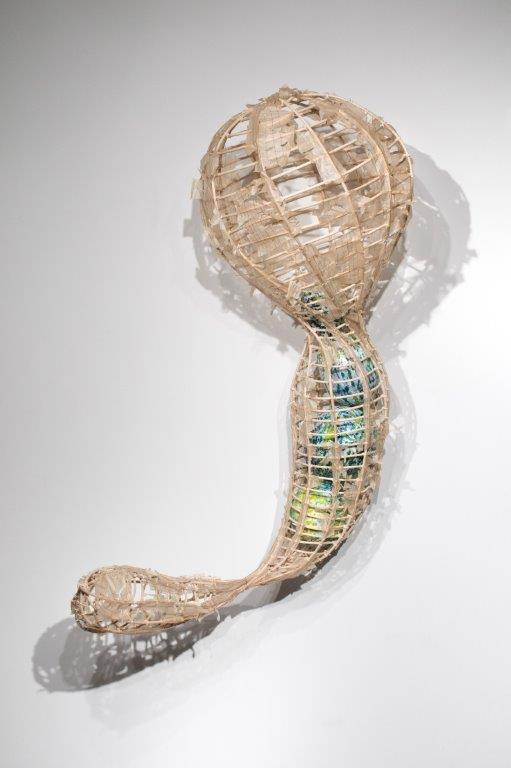
Fertile 2019. 51”H X 32” W x20D. Encaustic wax, Rattan reed, Cotton string, Adhesive and Dress maker’s tissue.
Can you take us briefly through your process?
Referring to my sketch I wrestle the reed to conform to the desired shape with clamps, I then tie off each junction with cotton string. When fully formed I glue each intersection then trim the form. From this stage the work might be left bare, or painted then enrobed in encaustic wax or the reverse. I carefully heat set the wax in stages.
You comment, “Movement, texture and complexity of form are integral.” Expand on this comment.
May I also add deceptively Effortless?
My own favorite sculptures are the ones that appear “effortless” or natural and organic- not forced. In reality those are the most complex forms to attain and their resolution the most rewarding. A little game I have is to question myself…
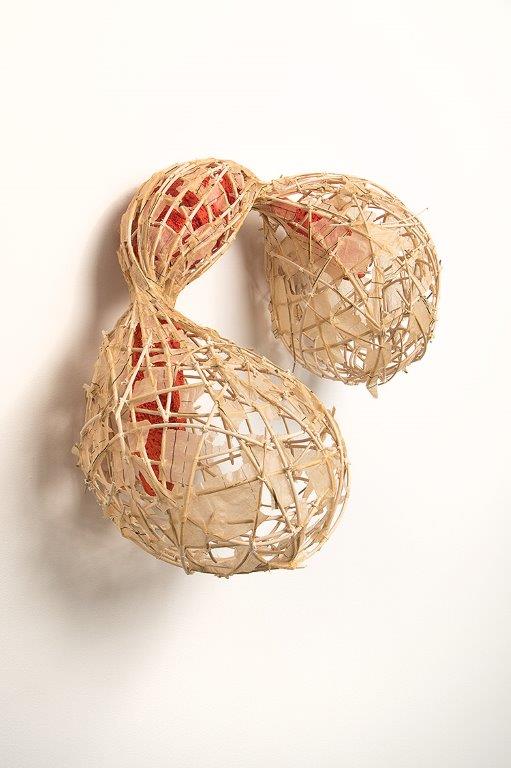
A Float 2017. 32”H X 21” W X 15” D. Encaustic wax, Rattan reed, Fabric, Cotton string, adhesive and Dress maker’s tissue
“What are my limits in complexity and design while still appearing natural and organic?”
“How can I entice the viewer to remain scanning the form so that both the sculpture and the experience is fluid with continued small visual revelations?”
“How does my choice of materials and texture effect the nature of the form?”
I have come to see there are distinct qualities connecting my sculptures that emerge from my hands and psyche, no matter what the medium.
- Playfulness- positive, quiet and unexpected.
- Gestural movement-caught in motion.
- Organic-very much alive and at peace.
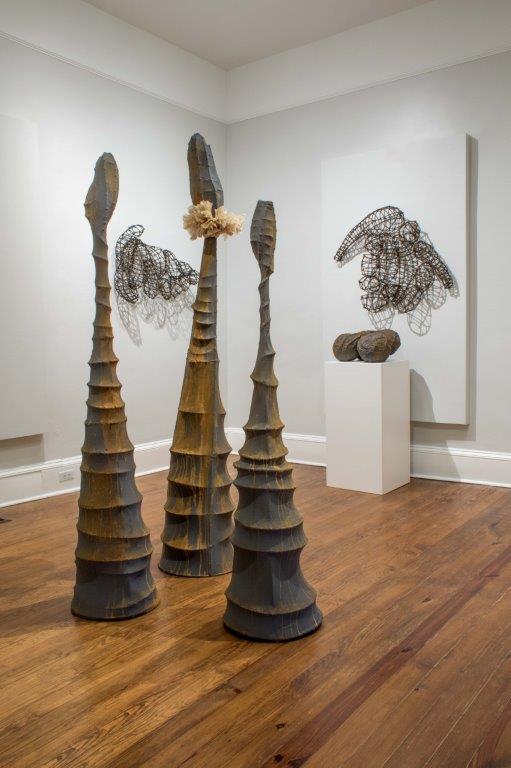 Early work Image. Untitled Vessel Ceramic 13”H X 5.5” W. Wheel Thrown with hand colored clay embellishments.
Early work Image. Untitled Vessel Ceramic 13”H X 5.5” W. Wheel Thrown with hand colored clay embellishments.
Contact:
Eileen Braun
#EileenBraunArt
Deborah Blakeley, Melbourne, Australia
Interview by Deborah Blakeley, April 2021
Think a colleague or friend could benefit from this interview?
Knowledge is one of the biggest assets in any business. So why not forward this on to your friends and colleagues so they too can start taking advantage of the insightful information the artist has given?
Other artists you may be interested in:


